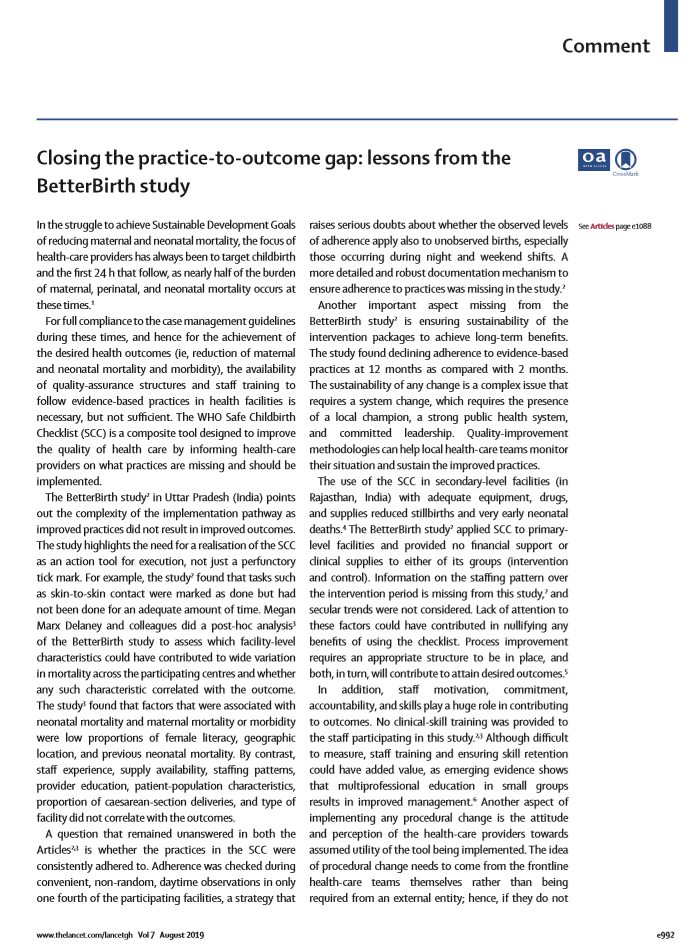This blog was originally published as a commentary in The Lancet Global Health here.
In the struggle to achieve Sustainable Development Goals of reducing maternal and neonatal mortality, the focus of health-care providers has always been to target childbirth and the first 24 h that follow, as nearly half of the burden of maternal, perinatal, and neonatal mortality occurs at these times.1
For full compliance to the case management guidelines during these times, and hence for the achievement of the desired health outcomes (ie, reduction of maternal and neonatal mortality and morbidity), the availability of quality-assurance structures and staff training to follow evidence-based practices in health facilities is necessary, but not sufficient. The WHO Safe Childbirth Checklist (SCC) is a composite tool designed to improve the quality of health care by informing health-care providers on what practices are missing and should be implemented.
The BetterBirth study 2 in Uttar Pradesh (India) points out the complexity of the implementation pathway as improved practices did not result in improved outcomes. The study highlights the need for a realisation of the SCC as an action tool for execution, not just a perfunctory tick mark. For example, the study2 found that tasks such as skin-to-skin contact were marked as done but had not been done for an adequate amount of time. Megan Marx Delaney and colleagues did a post-hoc analysis3 of the BetterBirth study to assess which facility-level characteristics could have contributed to wide variation in mortality across the participating centres and whether any such characteristic correlated with the outcome. The study3 found that factors that were associated with neonatal mortality and maternal mortality or morbidity were low proportions of female literacy, geographic location, and previous neonatal mortality. By contrast, staff experience, supply availability, staffing patterns, provider education, patient-population characteristics, proportion of caesarean-section deliveries, and type of facility did not correlate with the outcomes.
A question that remained unanswered in both the Articles2, 3 is whether the practices in the SCC were consistently adhered to. Adherence was checked during convenient, non-random, daytime observations in only one fourth of the participating facilities, a strategy that raises serious doubts about whether the observed levels of adherence apply also to unobserved births, especially those occurring during night and weekend shifts. A more detailed and robust documentation mechanism to ensure adherence to practices was missing in the study.2
Another important aspect missing from the BetterBirth study2 is ensuring sustainability of the intervention packages to achieve long-term benefits. The study found declining adherence to evidence-based practices at 12 months as compared with 2 months. The sustainability of any change is a complex issue that requires a system change, which requires the presence of a local champion, a strong public health system, and committed leadership. Quality-improvement methodologies can help local health-care teams monitor their situation and sustain the improved practices.
The use of the SCC in secondary-level facilities (in Rajasthan, India) with adequate equipment, drugs, and supplies reduced stillbirths and very early neonatal deaths.4 The BetterBirth study2 applied SCC to primary-level facilities and provided no financial support or clinical supplies to either of its groups (intervention and control). Information on the staffing pattern over the intervention period is missing from this study,2 and secular trends were not considered. Lack of attention to these factors could have contributed in nullifying any benefits of using the checklist. Process improvement requires an appropriate structure to be in place, and both, in turn, will contribute to attain desired outcomes.5
In addition, staff motivation, commitment, accountability, and skills play a huge role in contributing to outcomes. No clinical-skill training was provided to the staff participating in this study.2, 3 Although difficult to measure, staff training and ensuring skill retention could have added value, as emerging evidence shows that multiprofessional education in small groups results in improved management.6 Another aspect of implementing any procedural change is the attitude and perception of the health-care providers towards assumed utility of the tool being implemented. The idea of procedural change needs to come from the frontline health-care teams themselves rather than being required from an external entity; hence, if they do not consider the SCC an aid to their work, its use will remain theoretical.
A 2018 study7 in Haryana (India) that used a multipronged quality management strategy exposed many gaps and weakness in the health systems that can dilute quality-improvement efforts. The case studies in this work7 illustrate how local-staff commitment and motivation could play a huge role in improving the utilisation of services and implementing practices.
The first step in reducing perinatal, maternal, and neonatal mortality is dissemination of knowledge and translation to practice of the evidence-based interventions, and WHO SCC is one step in this journey. However, the BetterBirth study2, 3 shows practices can fail when applied in primary-care facilities. This study3 is important from the public health perspective in that it helps understand why evidence-based practices fail to produce desired outcomes and paves way for further research to address key issues and guide the judicious allocation of national resources to fix these gaps.
To summarise, the outcomes of Marx Delaney and colleagues’ study3 in no way imply that adherence to birth practices outlined in the SCC is not a worthwhile goal. Each of these practices has an evidence base in itself. However, use of the SCC is not a magic-bullet solution to the complex problem of improving maternal and neonatal health outcomes in low-income and middle-income countries. The Article3 rightly acknowledges that improved outcomes require tackling issues at multiple levels. Leadership and governance, supply chain and infrastructure, staff commitment and ongoing skill training for interprofessional teams, and establishment of a reliable referral system are some of the factors, in addition to practice of evidence-based interventions, that need attention to achieve the desired outcomes. The authors3 also rightly state the need for better-quality metrics that take into account all the mentioned factors.
We declare no competing interests.
